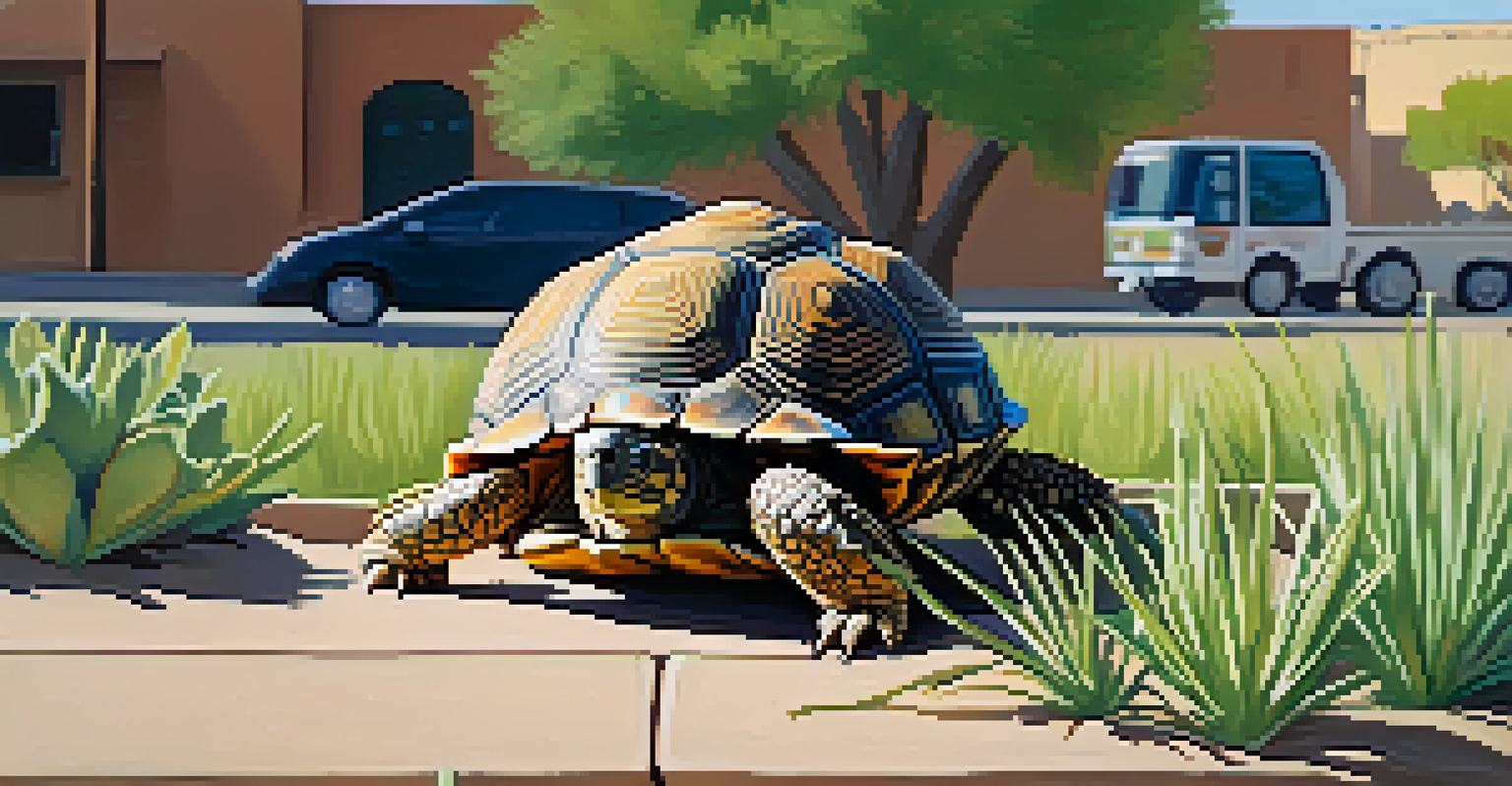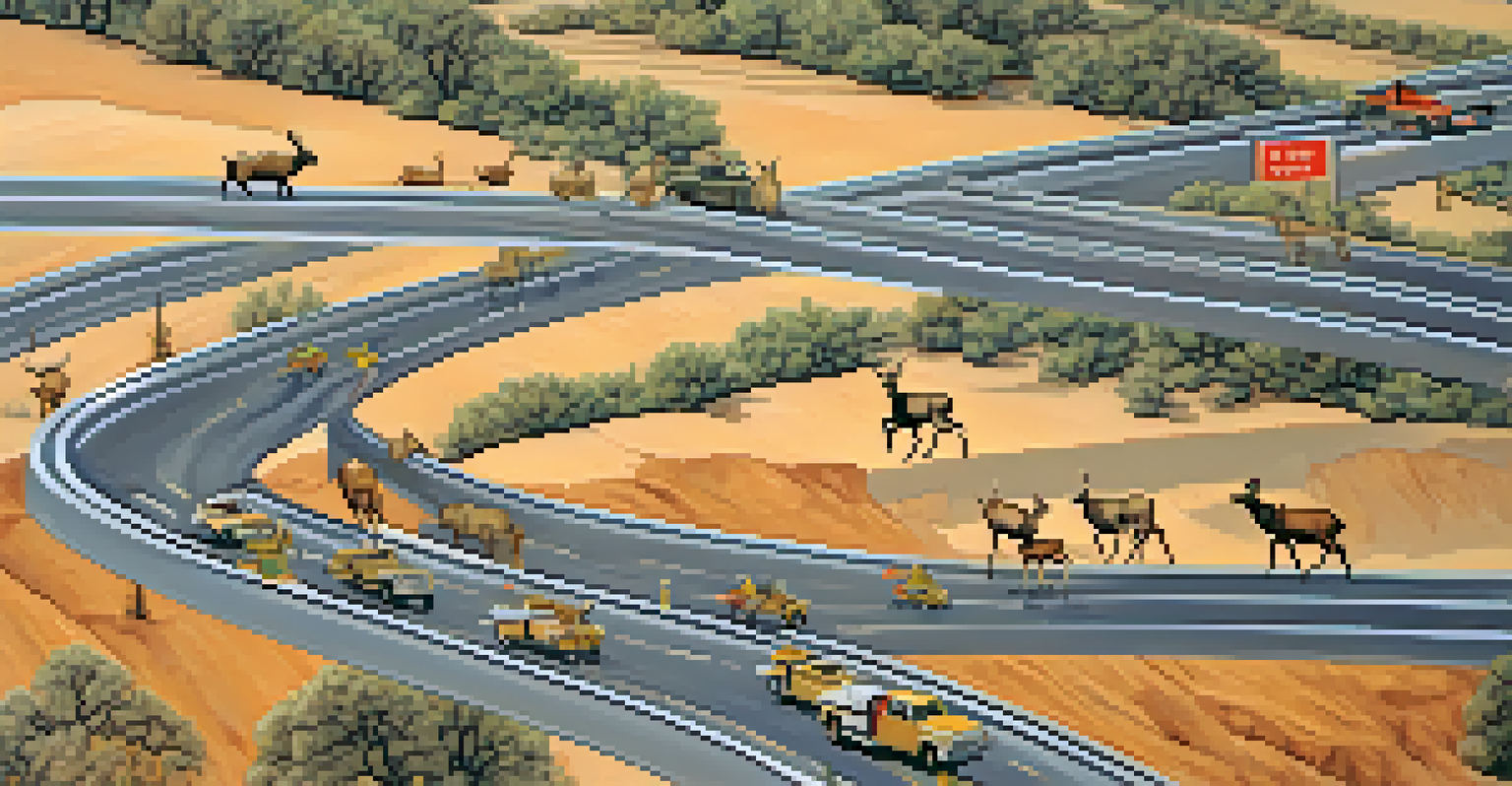Urbanization and Migration Patterns of Arizona's Wildlife

Understanding Urbanization in Arizona
Urbanization refers to the increasing population in urban areas, which has been particularly noticeable in Arizona over the last few decades. Cities like Phoenix and Tucson have expanded rapidly, leading to significant changes in land use and habitat availability. As more people move to these urban centers, natural landscapes are transformed into residential and commercial developments.
Urbanization is not just about buildings and roads; it's about the lives that are affected and the wildlife that is displaced.
This shift not only affects human communities but also has profound implications for local wildlife. Animals that once roamed freely in these areas now find their habitats fragmented or entirely replaced by buildings and roads. This situation creates challenges for wildlife as they struggle to adapt to their new environment.
Understanding urbanization is crucial to addressing its impact on wildlife. By recognizing how urban growth alters ecosystems, we can develop strategies to mitigate these effects and promote coexistence between humans and nature.
The Impact of Habitat Loss on Wildlife
Habitat loss is one of the most significant consequences of urbanization, posing a serious threat to wildlife in Arizona. As forests, grasslands, and wetlands are replaced by concrete and asphalt, many species lose their homes. This loss of habitat can lead to decreased populations and even extinction for some vulnerable species.

Moreover, habitat fragmentation can isolate animal populations, making it difficult for them to find mates or migrate to new areas with better resources. For instance, the desert tortoise, a native species to Arizona, faces challenges in finding suitable habitats due to urban sprawl and road construction. This isolation can weaken genetic diversity, further threatening their survival.
Urbanization Threatens Wildlife
Rapid urban growth in Arizona leads to habitat loss and challenges for local wildlife.
To address these issues, conservation efforts are essential. Initiatives such as creating wildlife corridors can help connect fragmented habitats, allowing animals to move freely and maintain healthy populations.
Migration Patterns of Arizona's Wildlife
Migration is a natural behavior for many species, allowing them to adapt to seasonal changes and find food. However, urbanization disrupts these migration patterns, forcing wildlife to alter their traditional routes. For example, animals like elk and mule deer typically migrate to find food and suitable breeding grounds but may now encounter urban barriers that impede their journey.
The future will be shaped by how we balance our urban growth with the needs of wildlife; it’s a shared responsibility.
Changes in migration patterns can lead to increased human-wildlife conflicts. Animals venturing into urban areas in search of food may find themselves in dangerous situations, such as crossing busy highways. This not only puts wildlife at risk but also poses safety threats to drivers and pedestrians.
Understanding these altered migration patterns is vital for developing effective wildlife management strategies. By studying how urbanization impacts animal movements, conservationists can propose solutions that help both wildlife and human communities thrive.
The Role of Urban Green Spaces
Urban green spaces, such as parks, gardens, and nature reserves, play a crucial role in supporting wildlife within cities. These areas provide essential habitats for various species, offering shelter and food sources amidst the urban landscape. In Arizona, green spaces can help mitigate some of the negative effects of urbanization by serving as refuge areas for wildlife.
Additionally, urban green spaces can facilitate the movement of animals, making it easier for them to navigate through the city. For example, birds often use parks as stopping points during migration, allowing them to rest and refuel before continuing their journeys. These spaces not only benefit wildlife but also enhance the quality of life for residents.
Importance of Urban Green Spaces
Parks and gardens provide crucial habitats and corridors for wildlife amidst urban environments.
Promoting the creation and maintenance of urban green spaces is vital for fostering biodiversity. By integrating nature into urban planning, Arizona can create environments where both people and wildlife can coexist harmoniously.
Community Involvement in Wildlife Conservation
Community involvement is essential in addressing the challenges posed by urbanization on Arizona's wildlife. Residents can play a significant role in supporting local conservation efforts, whether through volunteering, participating in wildlife monitoring programs, or advocating for sustainable urban planning. Engaging the community fosters a sense of responsibility and awareness regarding wildlife issues.
For example, local schools can organize educational programs to teach students about native species and their habitats. This knowledge empowers the next generation to appreciate and protect their natural surroundings. Community events, like clean-up days or habitat restoration projects, can also bring people together to make a tangible difference in their local ecosystems.
By fostering a community-centric approach to wildlife conservation, Arizona can create a culture of stewardship that encourages the protection of its unique natural heritage. When individuals feel connected to their environment, they are more likely to take action to preserve it.
Future Prospects for Arizona's Wildlife
Looking ahead, the future of Arizona's wildlife will largely depend on how effectively we address the challenges posed by urbanization. Innovative solutions, such as wildlife-friendly urban designs and improved land-use planning, can help mitigate the impacts of urban growth. Collaborating with urban planners, conservationists, and the community will be crucial in shaping a more wildlife-friendly environment.
Furthermore, public awareness campaigns can educate residents about the importance of preserving local wildlife and habitats. Engaging storytelling and relatable anecdotes can inspire people to support conservation initiatives actively. For instance, sharing success stories of species that have thrived due to community efforts can motivate others to get involved.
Community Role in Conservation
Engaging local residents in conservation efforts fosters a culture of stewardship for Arizona's wildlife.
Ultimately, by prioritizing wildlife conservation in the face of urbanization, Arizona can work towards a future where both people and wildlife coexist and thrive. The right strategies and community engagement can pave the way for a more sustainable and harmonious relationship with nature.
Conclusion: Balancing Urban Growth and Wildlife Needs
In conclusion, the rapid urbanization in Arizona presents both challenges and opportunities for its wildlife. While habitat loss and altered migration patterns pose significant threats, community involvement and innovative urban planning can help mitigate these issues. Recognizing the importance of urban green spaces and engaging local residents can foster a culture of conservation that benefits both wildlife and humans.
As we move forward, it is crucial to prioritize wildlife needs in our urban development plans. By striking a balance between growth and conservation, Arizona can create a future where urban areas and natural ecosystems coexist. This approach not only protects the unique wildlife that calls Arizona home but also enhances the quality of life for its residents.

Ultimately, the responsibility lies with all of us to ensure that our urban landscapes do not come at the cost of our natural heritage. Together, through awareness, education, and proactive conservation efforts, we can create a thriving environment for both wildlife and communities in Arizona.